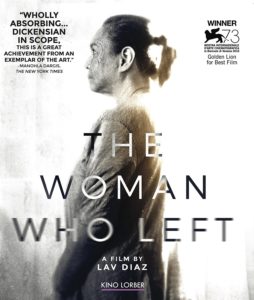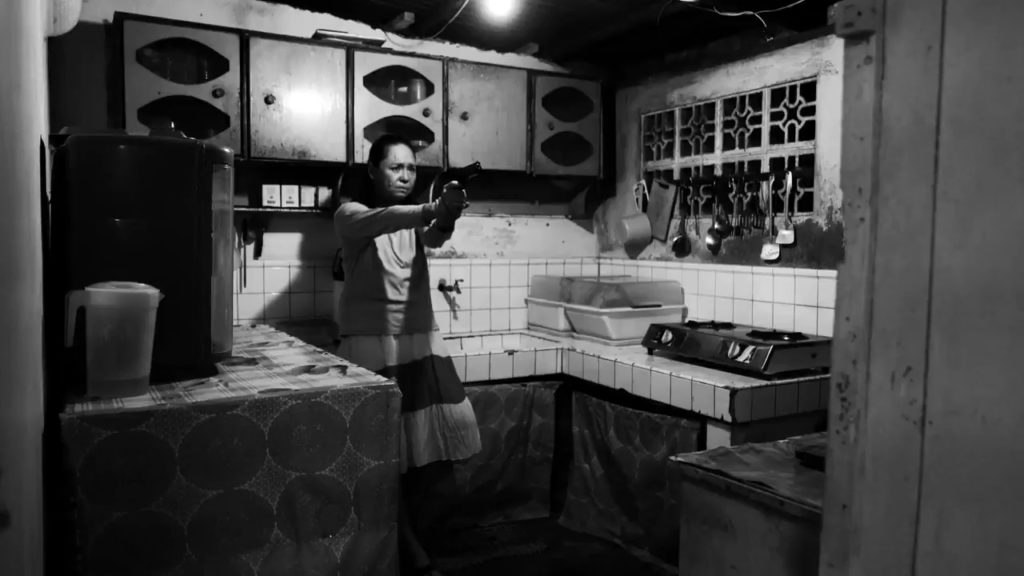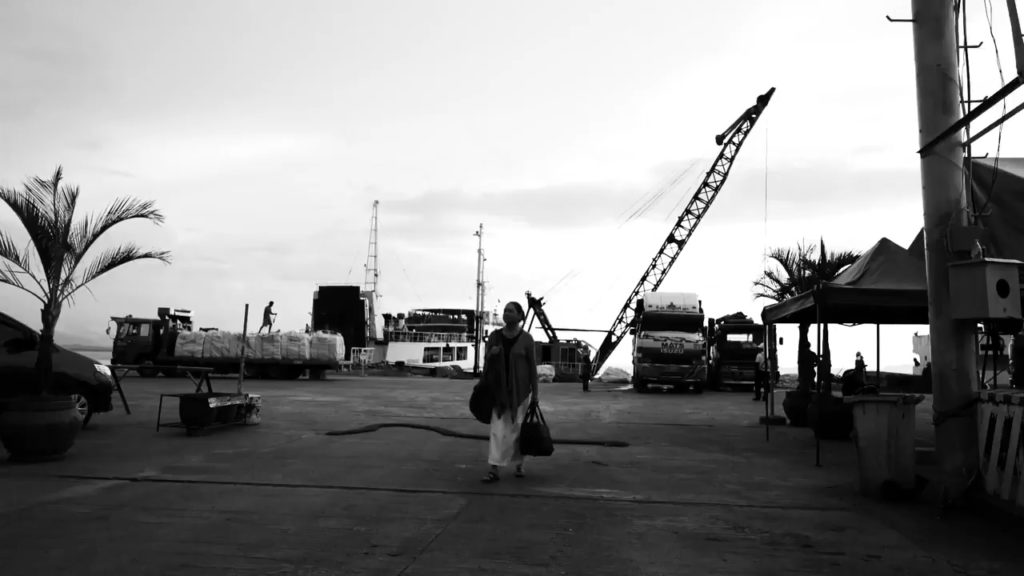Or: “Rodrigo Trinidad Must Die. Eventually.”
DIRECTED BY LAV DIAZ/FILIPINO, JAPANESE/2017 (U.S. Theatrical Release)
STREET DATE: JANUARY 23, 2018/KINO LORBER
 The Woman Who Left (native title: Ang babaeng humayo) is a nearly four-hour black and white “slow cinema” tale filled with lots of real human pain, but no close-ups. Each scene is a single shot, with no camera movement of any kind. Dialogue is sparse, and primarily in Filipino and Japanese; exposition is non-existent. It’s a revenge thriller.
The Woman Who Left (native title: Ang babaeng humayo) is a nearly four-hour black and white “slow cinema” tale filled with lots of real human pain, but no close-ups. Each scene is a single shot, with no camera movement of any kind. Dialogue is sparse, and primarily in Filipino and Japanese; exposition is non-existent. It’s a revenge thriller.
Imprisoned for thirty years for a murder she didn’t commit, former educator Horacia Somorostro is shocked to one day be unceremoniously freed. After a tearful reunion with her now-adult daughter, and the news that her son has long since gone missing, Horacia slowly, meticulously throws herself wholly into tracking the routines and whereabouts of the man who framed her, one rich and powerful Rodrigo Trinidad (Michael De Mesa). This long, slow process involves acquisition of a gun, inquiring of Trinidad’s weekly outings, and going undercover at all hours.
Every line in [director Diaz’s] frames seem to point to the characters, yet the characters are also engulfed; awash in the static, deep focus world all around them.
Amid this hardening, bloodthirsty quest, Horacia cannot suppress her humanitarian heart. When an odd and enigmatic transvestite (John Lloyd Cruz) falls victim to a brutal assault, Horacia takes it upon herself to treat and restore the individual. Consequently, The Woman Who Left takes shape as an exploration into the tension between an altruist’s selfless nature, and one’s own burning need for rough justice. The film is a unique grapple with the most beautiful and ugly aspects of human nature, and, to be blunt, a Gospel-love presentation that flies in the face of a community that practices a facade-like religion, but evidences no true faith – even the ornate church itself.
Playing Horacia is Charo Santos-Concio, a one-time famous mainstream actress who long ago crossed over to the corporate side of the bustling Filipino film industry. Quite remarkably, Santos-Concio opted to make her return to the big screen in this off-kilter low budget indie from perennial outsider, Lav Diaz.

Charo Santos-Concio in THE WOMAN WHO LEFT
Filmmaker Diaz, the director/writer/producer/editor/cinematographer of The Woman Who Left, is famously and infamously known for his championing and furthering of long-form narrative cinema. A festival darling but also an artistic pariah in his native Philippines, where glossy romcoms rule the screen, this effort is nonetheless prestigious. It is nothing less than the 2016 winner of the Golden Lion, the top prize at the Venice Film Festival. Yet, even at three hours and forty-six minutes in length, The Woman Who Left is on the shorter end of Diaz’s filmography. His argument, successful both here and in the past, has been that any given film ought to be as long as it needs to be, as opposed to conforming to the truncated desires of festivals, exhibitors and human bladders. Indulgent? Arguably, yes. Fundamentally correct? Absolutely. Any shorter or choppier, and The Woman Who Left fails as the emotionally immersive time-owning experience that it is.
Diaz, shooting with limited crew and equipment primarily at night in the actual slums of the country, favors natural, non-polished performances while clearly harnessing his gift for visual composition. Every line in his frames seem to point to the characters, yet the characters are also engulfed; awash in the static, deep focus world all around them. The threshold between white and black can sometimes be thin, resulting in beautifully inky night shots, punctuated with intermittent street light. Other times, the intended grayness of the image threatens to swallow everything whole.

I’ve seen this movie twice now, once as a streaming link and now on blu-ray. There is no comparison, the image quality of the blu-ray is far and away superior. Image quality is important on any film experience, though in the case of a film like this, the vitality is compounded. The Woman Who Left may not be a film most people would watch very often, but it nevertheless deserves a spot in any World Cinema disc library, just as any great literature fan’s bookshelf would house the great works of Leo Tolstoy – whose story, “God Sees the Truth, But Waits”, inspired Diaz’s screenplay.
Bonus content includes a five minute “making of” video that’s actually a promotional hard-sell. There’s also the theatrical trailer, a considerably more toned down and accurate depiction of this sparse yet engrossing music-free film. Finally, there’s a full color multi-page booklet containing a very insightful essay by Gil Quito, which contains a good bit of the information relayed here, and plenty more.
The Woman Who Left may or may not be a masterpiece, time will tell. But the time spent with it, however one may process its expenditure, cannot be in vain, or forgotten.

